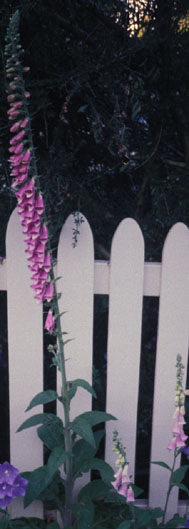
|

|

|
| Foxglove; Digitalis purpurea L. |
Plantain Family; PLANTAGINACEÆ
|
formerly Figwort Family; SCROPHULARIACEÆ
|
| Foxglove is a biennial or short-lived perennial herb. A very pretty plant, it has been thought of in many ways: it is a wildflower, a
weed, a garden ornamental, a potent medicinal plant, and one of the deadliest of the more common poisonous plants. Any plant so important
is worth knowing. |
| Originally from Europe, Foxglove has been naturalized in the Seattle area for decades. It comes up wild in many places, favoring
rich soil and partial shade; it hates hot, dry, sunny sites. Seeds sprout in any month except the coldest, and proceed to build up a mounded
circle of soft, limp, fuzzy foliage. In spring a stout flower stem surges straight up, bearing its "finger-glove" flowers beginning in May and
lasting into July. The largest Foxglove plants reach
71/2 feet in height, having secondary flowerstems ringing the primary one, and end up
opening nearly 950 flowers! Each flower makes a squat pod that contains hundreds of tiny seeds. |
| It is mostly Foxglove's showy flowers that attract attention. They are light purple to mauve, or white and
spotted. They have been called Bloody Man's Fingers, Dead Man's Bells, Fairies' Petticoats, and Witches' Thimbles. The name
Digitalis also has reference to the finger-fitting flowers. Other names are Dog's Lugs and Poppy Dock. |
| Rank young specimens in early spring have been mistaken for Comfrey
(Symphytum) by some inexperienced people, who died
after ingesting a tea made from the leaves. Even a few seeds can cause a life-threatening reaction. It is, in brief, very toxic. However, more
lives have been saved by Foxglove than ended by it; it is a valuable heart medicine when given in carefully regulated dosage. |
It is not a troublesome weed, being easily pulled up; and if not pulled up, is a beautiful sight. Yet do not spill any ripened seeds
onto your compost heap, unless you don't mind your finished compost nourishing countless Foxglove seedlings.
|
Originally published as the Seattle Tilth newsletter Weed of the Month in July 1988, along with an illustration drawn by Sylvan Haven.
Back |
|
|

